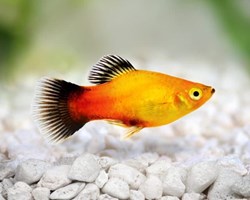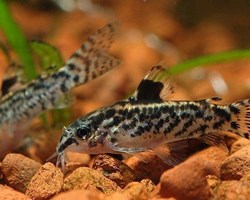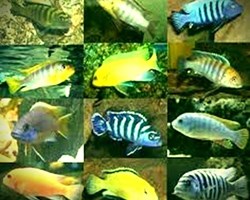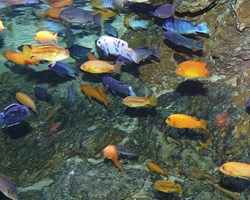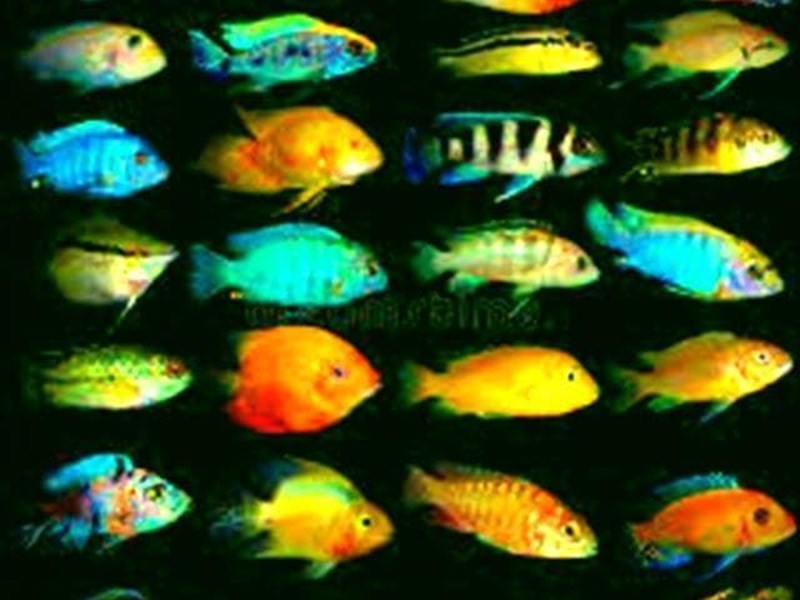
THE AFRICAN CICHLIDS: THEIR CARE AND ADAPTATION.
The African continent contains Lakes Tanganyika, Malawi and Victoria, three huge lakes that are home to a wide variety of fascinating cichlids.
With over 300 species of cichlids available in Lake Malawi, there is no shortage of options to keep in an aquarium.
The variety of colors and sizes that exist offers aquarium enthusiasts the opportunity to have freshwater tropical fish, which rival the beauty of saltwater fish.
Most of the cichlids in Lake Malawi belong to the Mbuna group.
The name Mbuna means "rock fish" in the language of the Tonga people of Malawi.
An aquarium setup for Mbuna cichlid communities typically includes quite a few rocks with lots of caves and lots of fish.
The rock decoration should be carefully built from the bottom of the aquarium up, using stable rocks to prevent the structure from collapsing.
The substrate should be sand and fine gravel, and should be added after the rocks have their established position, without covering the base rocks.
Malawi cichlids are prolific burrowers and can easily cause rock structures placed on the substrate to collapse if they are not on the glass of the aquarium base.
Having lots of fish helps the more dominant males not harass other males as often, thus preventing loss of fish.
It is to be expected that this type of community aquarium will present frequent aggressive gestures, especially by dominant males.
Aquariums for Lake Malawi fish should be large: 1m or more, and at least 200L or more in volume.
Strong and efficient filtration is necessary, as the aquarium will be teeming with fish.
The plants are difficult to maintain, since these species are herbivorous and burrow into the substrate.
Some species of the genera Labidochromis and Pseudotropheus allow Vallisneria in pots to survive, yes, if they are sufficiently fed with spirulina tablets, but this cannot be 100% guaranteed.
It is difficult to state with certainty that any particular species of the genera Labeotropheus, Melanochromis, or Pseudotropheus is more or less aggressive than others.
Species of the genera Cynotilapia and Labidochromis are considered less aggressive.
We at Glu Glu Pet recommend the following guidelines when choosing inhabitants for a Lake Malawi community aquarium:
- Incorporate species with different body shapes.
- Select species of different colors.
- Select species from different genera.
- Buy groups of fry.
- Provide several females for each male.
- Mix species that have similar aggressive behavior.
- Avoid mixing cichlids from Lake Malawi with cichlids from Lake Tanganyika.
Species of the genus Aulonacara, commonly known as peacocks, Copadichromis, and Sciaenochromis are brightly colored.
These species are best kept in groups that have several females for each male.
It is advisable to have them in large aquariums, preferably 1m long or more, and at least 200L in volume.
They should be fed a typical carnivorous diet.
Aquariums should have some larger caves along with open areas of fine gravel or sand, and areas with Vallisneria spiralis or Vallisneria gigantea.

WATER CONDITIONS AND MAINTENANCE:
A temperature of 24°C to 26°C is required, with a GH value of approximately 200 to 280 mg/L, and a pH value ranging between 7.8 and 8.5.
Malawi cichlids appreciate regular water changes.
Because there are a lot of fish, and a lot of waste, it is recommended to do a 25% water change every week.
THE BEST NUTRITION:
Strict attention to diet is recommended.
The Mbuna group are algae eaters, and should have a diet rich in spirulina tablets and flakes, along with other vegetables. Supplementation with flakes of the Color Enhancer formula and frozen food based on vegetables works very well, but foods with a high protein content should be avoided.
Tanganyika cichlids, is a genus of fish with the following taxonomy:
· Animalia Kingdom.
Edge: Chordata.
· Class: Actinopterygii.
· Subclass: Neopterygii.
· Underclass: Teleostei.
· Superorder: Acantopterigii.
· Order: Perciformes.
· Family: Cichlids.
Lake Tanganyika is one of the great lakes in Africa.
It is estimated to be the second largest lake in the world by volume, and the second deepest lake, after Lake Baikal in Siberia,3 it is also the longest freshwater lake in the world.
The lake is divided between four countries: Tanzania, the Democratic Republic of the Congo, Burundi and Zambia, with Tanzania (46%) and the Democratic Republic of the Congo (40%) owning the majority of the lake.
The water flows into the Congo River and eventually into the Atlantic Ocean.
The average surface temperature is 25 °C and the average acidity, pH, is 8.4.4.
The lake contains at least 250 species of cichlid fish, cichlids and another 150 species of non-cichlid fish, most of which live on the lake shore, at a depth of 180 m.
TYPES OF AFRICAN CICHLIDS:
Yellow Cichlid Neolamprologus leleupi:
This cichlid is native to Lake Tanganyika, in Africa.
It usually inhabits waters with temperatures ranging between 23 and 26º C, with alkaline pH, between 7.5 and 8.5.
The water should be moderately hard (dH 15 at 25º).
Their diet is quite varied.
In captivity in the aquarium it adapts well to live and frozen foods such as daphnia and brine shrimp. Also provide dry and vegetable food for balance. It reaches a maximum size of 7 cm.
For it to adapt well to the aquarium, it will need a soft substrate and an abundance of large rocks that form caves.
In this way the characteristics of their wild habitat are reproduced. The males are aggressive among themselves and also with females despised by their group. They breed and spawn among the rocks. The female lays almost 100 eggs, which she defends vigorously.
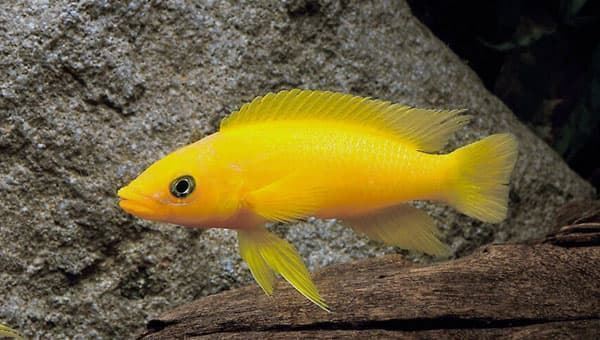
Julidochromis dickfeldi:
Julidochromis is found on the southwestern shore of Lake Tanganyika.
It lives in waters with temperatures ranging between 24 and 26º C, with a very alkaline pH that reaches up to 8.5.
As far as hardness is concerned, the values in which it lives reach up to 20º.
This cichlid is carnivorous.
In captivity in the aquarium it adapts well to live and frozen foods such as daphnia and brine shrimp.
It is a fairly small cichlid that barely reaches 8 cm in length.
It is not convenient to have this species with much larger specimens.
It adapts well in small groups in aquariums with many hiding places to delimit territories between males. In the wild, it lives among rocks, so you should prepare an aquarium with stones almost to the surface. If you mix it with other Julidochromis, it is very likely that it will reproduce, giving rise to hybridization.
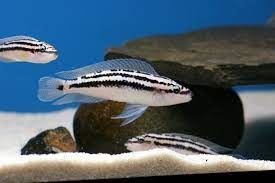
Labidochromis Caeruleus:
This cichlid is native to Lake Malawi, in Africa.It usually inhabits waters with temperatures ranging between 23 and 26º C, with a very generally alkaline pH, between 7.5 and 8.5.
The water should be slightly hard (dH up to 15º). Their diet is quite varied.
In captivity in the aquarium it adapts well to live and frozen foods such as daphnia and brine shrimp. Also provide dry and vegetable food for balance. It reaches a maximum size of 8 cm.
It is characterized as one of the most peaceful specimens of Lake Malawi.
Its pale body takes on more coloration during the reproductive period, especially the males. There are two varieties of this fish in the wild, with different feeding habits, although both are carnivorous. Both adapt well to life in captivity.
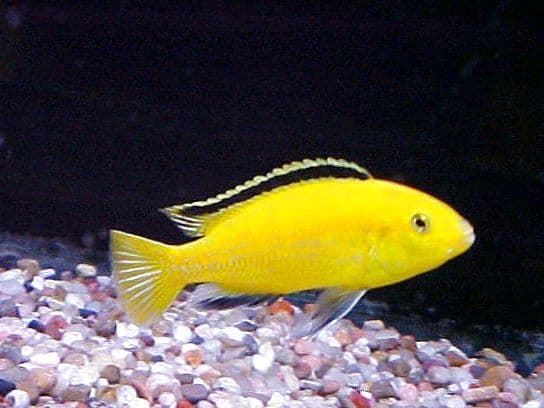
Lamprologus Sp:
This cichlid is native to Lake Tanganyika, where it inhabits waters with temperatures ranging between 23 and 26º C, with a very alkaline pH between 8 and 8.5.You must condition the aquarium water so that it has a hardness of no more than 20º.
Since it is omnivorous, its diet is quite varied.
In the aquarium it adapts well to live food such as daphnia and artemia, it can be frozen.
Also provide dry and vegetable food for balance.
It reaches a maximum size of 7 cm.
It is very attractive to the aquarium due to its bright colors and the length of its fins.
For a cichlid, it is a very calm fish even during the reproductive period. Be sure to provide rocks or large snails where they can spawn. The young remain hidden until they reach a certain level of development. Feed them freshly hatched shrimp.

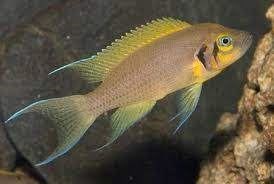
Melanochromis johanni:
This cichlid is native to Lake Malawi, in Africa.It usually inhabits waters with temperatures ranging between 23 and 26º C, with a very generally alkaline pH, between 7.5 and 8.5.
The water should be slightly hard, dH up to 15º.
Their diet is quite varied.
In captivity in the aquarium it adapts well to live and frozen foods such as daphnia and brine shrimp.
Also provide dry and vegetable food for balance. It reaches a maximum size of 7 cm.
Males are somewhat larger than females, also darker. Females are usually more orange. It is important that you have several females for each male present in the aquarium. They reproduce without difficulty. Each female has approximately 30 fingerlings that she takes care of in her mouth for a week. Then he releases them and stops paying attention to them.
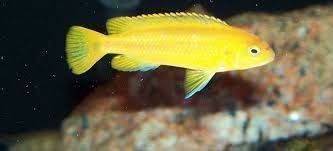
Neolamprologus brevis
This cichlid is native to Lake Tanganyika, in Africa.It usually inhabits waters with temperatures ranging between 23 and 26º C, with a very generally alkaline pH, between 7.5 and 8.5.
The water should be moderately hard (dH 15 at 25º).
Their diet is quite varied.
In captivity in the aquarium it adapts well to live and frozen foods such as daphnia and brine shrimp.
Also provide dry and vegetable food for balance. It reaches a maximum size of 4 cm.
This fish is very prone to reproduce in the aquarium.
The female prepares an improvised spawning site, generally composed of light stones or small pieces of wood that she buries in the substrate, which must be somewhat sandy. The pair fiercely defends the area around the eggs, so don't keep multiple pairs together if your tank isn't big enough. The female deposits approximately 20 to 25 eggs at a time.
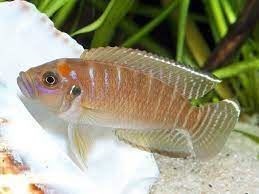
Pseudotropheus Estherae:
This cichlid is native to Lake Malawi.It usually inhabits waters with temperatures ranging between 23 and 26º C, with a markedly alkaline pH, between 7.5 and 8.5.
The water should be slightly hard, dH up to 10º.
Its diet is quite varied and in the aquarium it adapts well to live and frozen foods such as daphnia and brine shrimp.
Also accepts dried food.
It reaches a maximum size of 14 cm.
There are Pseudotropheus Estherae of various colors, from deep blue to orange and yellow.
Males are usually blue. They are fish very prone to reproduction, for which they will need spaces between the rocks. The females care for the fry through oral gestation.
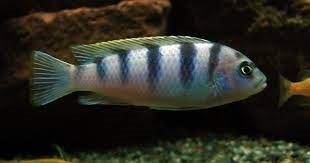
Pseudotropheus Zebra:
This cichlid is native to Lake Malawi, in Africa.It usually inhabits waters with temperatures ranging between 23 and 26º C, with alkaline pH, between 7.5 and 8.5.
The water should be slightly hard (dH up to 15º).
Their diet is quite varied.
In captivity in the aquarium it adapts well to live and frozen foods such as daphnia and brine shrimp. Also provide dry and vegetable food for balance.
It reaches a maximum size of 10 cm.
There are Pseudotropheus Zebra of several different colors.
They are territorial and polygamous, have at least 3 females for every male.
The females stay together and care for the fry through oral gestation.
Pseudotropheus eat algae and duckweed.


